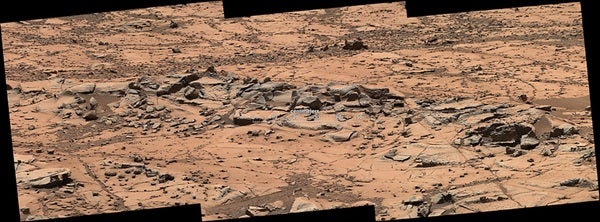Exposed layers on the lower portion of Mount Sharp are expected to hold evidence about dramatic changes in the environmental evolution of Mars. That was a major reason NASA chose this area of Mars for this mission. The lowermost of these slices of time ascending the mountain includes a pale outcrop called “Pahrump Hills.” It bears layers of diverse textures that the mission has been studying since Curiosity acquired a drilled sample from the outcrop in September.
In its first pass up this outcrop, Curiosity drove about 360 feet (110 meters) and scouted sites ranging about 30 feet (9m) in elevation. It evaluated potential study targets from a distance with mast-mounted cameras and a laser-firing spectrometer.
“We see a diversity of textures in this outcrop — some parts finely layered and fine-grained, others more blocky with erosion-resistant ledges,” said Ashwin Vasavada of NASA’s Jet Propulsion Laboratory in Pasadena, California. “Overlaid on that structure are compositional variations. Some of those variations were detected with our spectrometer. Others show themselves as apparent differences in cementation or as mineral veins. There’s a lot to study here.”
During a second pass up the outrcrop, the mission is using a close-up camera and spectrometer on the rover’s arm to examine selected targets in more detail. The second-pass findings will feed into decisions about whether to drill into some target rocks during a third pass to collect sample material for onboard laboratory analysis.
“The variations we’ve seen so far tell us that the environment was changing over time, both as the sediments were laid down and also after they hardened into bedrock,” Vasavada said. “We have selected targets that we think give us the best chance of answering questions about how the sediments were deposited — in standing water? flowing water? sand blowing in the wind? — and about the composition during deposition and later changes.”
The first target in the second pass is called “Pelona,” a fine-grained, finely layered rock close to the September drilling target at the base of Pahrump Hills outcrop. The second is a more erosion-resistant ledge called “Pink Cliffs.”
Before examining Pelona, researchers used Curiosity’s wheels as a tool to expose a cross section of a nearby windblown ripple of dust and sand. One motive for this experiment was to learn why some ripples that Curiosity drove into earlier this year were more difficult to cross than anticipated.
While using the rover to investigate targets in Pahrump Hills, the rover team is also developing a work-around for possible loss of use of a device used for focusing the telescope on Curiosity’s Chemistry and Camera (ChemCam) instrument, the laser-firing spectrometer.
Diagnostic data from ChemCam suggest weakening of the instrument’s smaller laser. This is a continuous wave laser used for focusing the telescope before the more powerful laser is fired. The main laser induces a spark on the target it hits; light from the spark is received though the telescope and analyzed with spectrometers to identify chemical elements in the target. If the smaller laser has become too weak to continue using, the ChemCam team plans to test an alternative method: firing a few shots from the main laser while focusing the telescope before performing the analysis. This would take advantage of more than 2,000 autofocus sequences ChemCam has completed on Mars, providing calibration points for the new procedure.
Curiosity landed on Mars in August 2012, but before beginning the drive toward Mount Sharp, the rover spent much of the mission’s first year productively studying an area much closer to the landing site, but in the opposite direction. The mission accomplished its science goals in that Yellowknife Bay area. Analysis of drilled rocks there disclosed an ancient lakebed environment that more than 3 billion years ago offered ingredients and a chemical energy gradient favorable for microbes, if any existed there.
Curiosity spent its second year driving more than 5 miles (8 kilometers) from Yellowknife Bay to the base of Mount Sharp with pauses at a few science waypoints.










